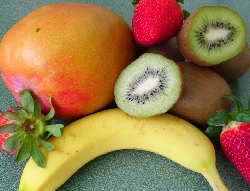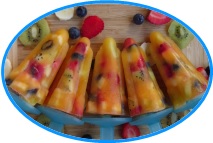Fresh Fruit Tips
Fresh Fruit

The most important aspect when making ice lollies is the ripeness of the fruit. A little forward planning may be needed as banana, kiwi, mango, and other fruits are not always completely ripe when you buy them from the shops, so they will need to ripen at home. If a banana is not ripe enough when blended with pineapple, there seems to be a reaction which effects the colour.
No sugar is added to these natural fruit ice lollies because the sweetness in the fruit ice lollies is acquired by timing the ripeness of the fruit correctly. If you are unsure how to prepare certain fruit or to see if they are ripe then please check the quick fruit guide before you start.
Fruit is a natural nutritious ingredient which is full of vitamins and minerals so ideal to use creatively and getting the children involved. Our twins made the Mottled ice lollies at the age of 7. Children much younger can make their own ice lollies and be proud of their achievement. Simply provide your children with some different colours of fruit puree (tip 1) and a teaspoon and let them place the fruit puree into the ice lolly moulds. It's a fun way of getting children involved and encourage healthier eating habits. The ice lollies are handy to have in the freezer ready to use on a busy day.
Late spring and summer are the best times to make ice lollies because there is so much different fruit to choose from. Summer fruit can be expensive but by blending them together with other less expensive fruits only small quantities are required and it makes a real difference to the taste.

Having homemade ice lollies ready for use in the freezer is very convenient. It takes little time to take the frozen fruit lollies out of the ice lolly mould, instead of reaching for a less nutritious snack. Life can be very hectic and sometimes we experience a bad food day. Just eating an ice lolly with the knowledge there is some nutrition in it too can make you feel a whole lot better!
Freezing Fruit Puree
Remember not to over-fill the ice lolly moulds or small freezer containers with the fruit puree. The water in the puree expands slightly when frozen so the tops of the ice lolly moulds, or container lids could be forced off. The length of time for the purees to be completely frozen depends on the size of the ice lolly moulds and the freezer used. Generally, small ice lollies will be ready to eat at teatime if they were made early morning. Ice lollies made at night can be ready for eating the next day. Fruit purees tend to deteriorate quickly so they need to be eaten or frozen immediately, once they have been made, so that they do not spoil. Once thawed, do not refreeze the fruit purees.
- Please note
It is up to individuals to make sure that the fruit used for making ice lollies is unblemished (of good quality), and to decide how long they wish to freeze the ice lollies for. The ice lollies on this website froze well for me for up to 3 weeks in a 4-star freezer, though often they were eaten well within that time! - As a sugar (fructose) is found naturally in fruit, this may need to be considered for anyone who has to watch their sugar intake due to health reasons.
A Quick Fruit Guide
I was once asked by a friend how I use oranges when making ice lollies, so in case others are unsure on how to prepare certain fruits, I've added a list of the fruits I use for the ice lolly recipes. It is a quick guide as to how I check to see if the fruit is ripe and prepare, prior to making the ice lollies. It is important that all the fruit is thoroughly washed before making the homemade ice lollies.
Apricots - A ripe apricot has a sweet aroma and feels slightly soft when gently squeezed. The stone needs to be taken out before use.
Banana - A ripe banana has brown spots on its skin. The spots indicate that the sugar content has risen in the ripening process. It goes without saying, a banana needs to be peeled.
Blueberries - Ripe blueberries should have a relatively smooth skin when they are ripe. If there are any stalks they need to be removed.
Cherries - Dark sweet cherries are best for making ice lollies. Ripe cherries should have a relatively smooth skin with no bruising. The stems should look green and fresh. The stalk needs to be removed and the stone taken out.
Clementine - Slice the clementine in half and squeeze the juice out. Use the juice and pulp for the puree and remove the pips.
Kiwi - The skin of a ripe kiwi should be brown and give slightly, when gently squeezed. It should be soft but not too soft and needs to be peeled.
Mango - Peel the mango, use the flesh, and take the stone out. To check for ripeness, it needs to be slightly soft when gently squeezed.
Orange - Slice the orange in half and squeeze the juice out. Use the juice and pulp of the puree and remove the pips.
Peach - A good ripe peach has a sweet aroma and feels slightly soft when gently pressed. The stone needs to be removed.
Pineapple - Chop off the top and bottom of the pineapple, the thick skin and remove the woody middle. Cut the pineapple in small pieces prior to blending. Alternatively, to save time, use tinned pineapple in natural juice.
Plum - Ripe plums smell sweet, feel slightly soft to touch and have a smooth skin. The stone needs to be removed.
Raspberries - Ripe raspberries should be bright, consistently coloured and look full and juicy. Raspberries need to be hulled.
Satsuma - Slice the satsuma in half and squeeze the juice out. Use the juice and pulp for the puree and remove the pips.
Strawberries - Ripe strawberries should be a red colour with not bits of white or green, indicating it is under-ripe. A sweet aroma may be present to indicate ripeness. Strawberries need to be hulled.
Site Map
Fruit Ice Lollies (home)
Easy Fruit Ice Lollies
Freezing Fruit Puree
Ice Lolly Recipes
Ice lolly Tips
Reluctant Fruit Eaters
Older Children
Pineapple Ice Lolly Recipe
Mango Ice Lolly Recipe
Kiwi Ice Lolly Recipe
Orange Ice Lolly Recipe
Traffic Light Ice lolly
Blackberry Ice Lollies
Ice Lolly Recipe
Book
(printed booklet)
Ice Lolly Comments
About Fruit Ice Lollies
Contact Fruit Ice Lollies
